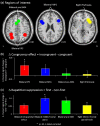A new perspective on the role of the frontoparietal regions in Stroop-like conflicts
- PMID: 37226979
- PMCID: PMC10318243
- DOI: 10.1002/hbm.26347
A new perspective on the role of the frontoparietal regions in Stroop-like conflicts
Abstract
Humans are goal-directed; however, goal-unrelated information still affects us, but how? The Stroop task is often used to answer this question, relying on conflict (incongruency) between attributes, one targeted by the task and another irrelevant to the task. The frontal regions of the brain are known to play a crucial role in processing such conflict, as they show increased activity when we encounter incongruent stimuli. Notably, the Stroop stimuli also consist of conceptual dimensions, such as semantic or emotional content, that are independent of the attributes that define the conflict. Since the non-targeted attribute usually refers to the same conceptual dimension as the targeted-attribute, it is relevant to the task at hand. For example, when naming the emotion of an emotional face superimposed by an emotional word, both the targeted-attribute and the non-targeted attribute refer to the conceptual dimension "emotion". We designed an fMRI paradigm to investigate how conflicts between different conceptual dimensions impact us. Even though the conflict was task-irrelevant, incongruent stimuli resulted in longer reaction times, indicating a behavioral congruency effect. When examining the neural mechanisms that underlie this effect, we found that the frontal regions exhibited repetition suppression, while the bilateral intraparietal sulcus (IPS) showed a congruency effect linked to the behavioral effect. Taken together, these findings suggest that individuals are unable to completely ignore task-irrelevant information, and that the IPS plays a crucial role in processing such information.
Keywords: attention; conflict adaptation; conflict monitoring; congruency effect; intraparietal sulcus; repetition suppression.
© 2023 The Authors. Human Brain Mapping published by Wiley Periodicals LLC.
Conflict of interest statement
The authors declare no competing financial interests.
Figures



Similar articles
-
The human body odor compound androstadienone increases neural conflict coupled to higher behavioral costs during an emotional Stroop task.Neuroimage. 2018 May 1;171:364-375. doi: 10.1016/j.neuroimage.2018.01.027. Epub 2018 Jan 12. Neuroimage. 2018. PMID: 29339313 Clinical Trial.
-
Turning down the heat: Neural mechanisms of cognitive control for inhibiting task-irrelevant emotional information during adolescence.Neuropsychologia. 2019 Mar 4;125:93-108. doi: 10.1016/j.neuropsychologia.2018.12.006. Epub 2019 Jan 4. Neuropsychologia. 2019. PMID: 30615898 Free PMC article.
-
The neural mechanisms of semantic and response conflicts: an fMRI study of practice-related effects in the Stroop task.Neuroimage. 2013 Feb 1;66:577-84. doi: 10.1016/j.neuroimage.2012.10.028. Epub 2012 Oct 24. Neuroimage. 2013. PMID: 23103691
-
Modulation of conflicts in the Stroop effect.Acta Psychol (Amst). 2018 Sep;189:93-102. doi: 10.1016/j.actpsy.2017.10.007. Epub 2017 Nov 1. Acta Psychol (Amst). 2018. PMID: 29078981
-
Limitations of cognitive control on emotional distraction - Congruency in the Color Stroop task does not modulate the Emotional Stroop effect.Cogn Affect Behav Neurosci. 2022 Feb;22(1):21-41. doi: 10.3758/s13415-021-00935-4. Epub 2021 Nov 4. Cogn Affect Behav Neurosci. 2022. PMID: 34735694 Free PMC article.
Cited by
-
Associations between neurolinguistic deficits and personality traits in people with epilepsy.Front Neurol. 2024 Oct 16;15:1416713. doi: 10.3389/fneur.2024.1416713. eCollection 2024. Front Neurol. 2024. PMID: 39479006 Free PMC article.
References
-
- Banich, M. T. , Milham, M. P. , Jacobson, B. L. , Webb, A. , Wszalek, T. , Cohen, N. J. , & Kramer, A. F. (2001). Attentional selection and the processing of task‐irrelevant information: Insights from fMRI examinations of the stroop task. In Progress in brain research (pp. 459–470). Elsevier. https://pubmed.ncbi.nlm.nih.gov/11702561/ - PubMed
-
- Botvinick, M. M. , Braver, T. S. , Barch, D. M. , Carter, C. S. , & Cohen, J. D. (2001). Conflict monitoring and cognitive control. Psychological Review, 108, 624–652. - PubMed
MeSH terms
LinkOut - more resources
Full Text Sources

